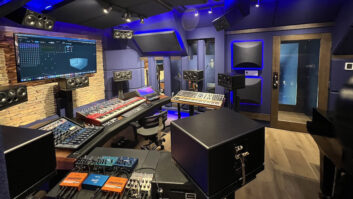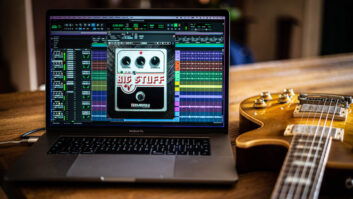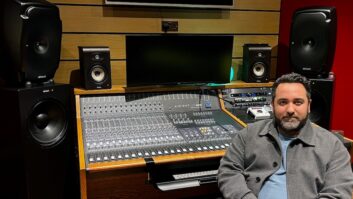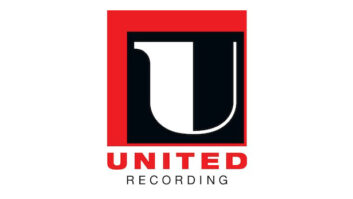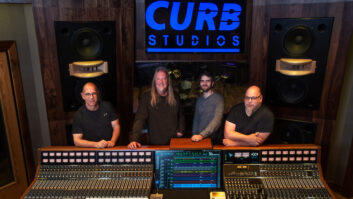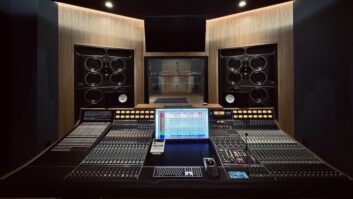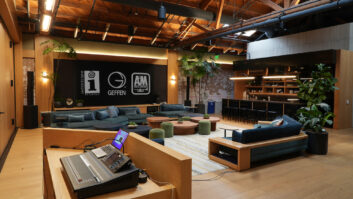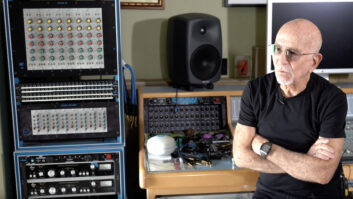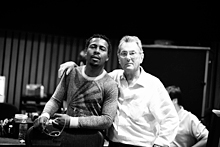
Roy Hargrove (left) and Al Schmitt in Capitol Studio A’s control room.
Photo: Chris Schmitt
Veteran jazz trumpeter, composer and bandleader Roy Hargrove (pictured, left, with Grammy Award-winning engineer Al Schmitt) brought his 19-piece big band to Capitol Studios in Hollywood to record and mix the band’s debut album, Emergence, which releases today on the Groovin’ High/Emarcy label. “At this point this is probably the worst thing I could ever do, financially speaking,” Hargrove says. “But it’s something that needs to be done, spiritually and musically speaking.”
With the big band, Hargrove indulges in his lifelong affection for the expansive sounds created by Dizzy Gillespie, Count Basie, Duke Ellington, Maynard Ferguson and Gerald Wilson, all of whom he cites as influences. “The small group has been such a big deal for so long in jazz that people forget where the small groups came from,” says Hargrove, who has already showcased the Roy Hargrove Big Band in the Hollywood Bowl and SummerStage in New York’s Central Park.
The 11 tracks on Emergence feature Hargrove on trumpet and flügelhorn. Hargrove’s ensemble comprises four trumpet players (Frank Greene, Greg Gisbert, Darren Barrett, Ambrose Akinmisure); four trombonists (Jason Jackson, Vincent Chandler, Saunders Sermons and Max Seigel on bass trombone); five woodwind players (Bruce Williams, alto saxophone and flute; Justin Robinson, alto and flute; Norbert Stachel, tenor sax and flute; Keith Loftis, tenor and flute; and Jason Marshall, baritone sax and flute); and a rhythm section comprising pianist Gerald Clayton, bassist Danton Boller, guitarist Saul Rubin, drummer Montez Coleman and percussionist Roland Guerrero. Guest vocalist Roberta Gambarini contributed to two tracks.
For the album’s repertoire, Hargrove sifted through his book of original compositions and favorite interpretations to come up with a well balanced mix of ballads and swingers, Latin jams and Tin Pan Alley standards. “When I get in the studio I might get inspired and change something around, according to the moment,” Hargrove says. “I’m just trying to make some music that’s fun to hear and play. There’s nothing like the feeling you get when you’re hearing your compositions and arrangements played by a wall of sound.”
Hargrove and his manager, Larry Clothier, produced Emergence, with Al Schmitt engineering and mixing in Capitol Studio A. Schmitt recorded the band into Pro Tools using 24 inputs on Studio A’s Neve VR console. As a bonus, Al Schmitt invited his son, photographer Chris Schmitt, to document one of the sessions; click here to view Chris Schmitt’s photos of a Roy Hargrove Big Band session in Capitol Studio A.
Mix recently spoke with Al Schmitt by phone to ask about the story behind the photos.
How did your son Chris’s session photos come about?
He travels around the world a lot as a photographer. He was home so I asked him if he’d come by and shoot some shots just for the fun of it. So he came by and did it, and then Larry Clothier just loved his shots and wanted them. I think they’re going to use some of them on the actual album. So hopefully they’ll pay him [laughs].
Does he photograph musicians?
Not necessarily. He does all kinds of work: portraits, weddings. He travels all over. He just went to Tuscany to do a wedding there. People fly him all over the world, so he’s doing really well. He’s got a great life.
How did you approach setting up these sessions?
Well, I still get to do a lot of big band arrangements. I did Paul Anka’s Rock Swings, and that was all big band. The way I approached it is the way I normally approach the band: I set up the band in the studio so everybody can see one another and everybody can hear one another, and it was just conventional. I set up the five saxophones on one side and the four trombones and four trumpets on the other side, kind of in a diagonal shape facing the conductor, Roy, who was standing in the middle of the room. And then the rhythm section was right behind them and the percussionist was in that area, too. So they were like a “V,” facing Roy, and then right behind the saxes and trumpets and trombones were the rhythm section and percussion. And then we had a little vocal booth where we had Roberta Gamborini, the vocalist.
Were the drums or percussion isolated?
The drums were isolated; percussion wasn’t. The drums were in the booth. Everybody else was out in the open except for the drums and the vocals.
The band has been on the road, and they were so well rehearsed because they were playing at a club in town, and so I had them from like noon until about 5:30 or six o’clock, and just about everything was first-take. I mean, the band was just swinging—they were so tight. And of course Roy is such an incredible player. It was great. The solos were great. Most of the arrangements were done by guys in the band. So it was a lot of fun. Those things are always great to do.

Over how long a period of time were these sessions?
We did them in two afternoons. I think we did something like 18 songs in two days. Yeah, it was amazing.
And like you were saying, it was first takes most of the way.
Yeah,
most of them were first takes. It was pretty rare that there was a take
two. But the band was so tight, and we had a great time. It just
sounded great, so when they came in and heard the first playback,
everybody was happy and it just went from there.
Which microphones did you employ?
On the five
saxophones I had Neumann U67s. On the four trombones I had Royer ribbon
mics, and on the four trumpets I had U67s. And all of the 67s were in
the omni position, so they were open all the way around. And then I had
two room mics up: M149s that were open all the way, non-directional.
How about the rhythm section and the percussion?
On
the bass I had two 149s and on the piano two M149s. On the guitar I had
a Royer, and then on the drums I had a D-112 on the kick, I had a 57
under the snare, and on top of the snare I had a 452, and the mic under
the snare was out of phase. I had a 452 on the hi-hat and two 452s on
the overheads, and on the toms I had AKG 414s. On the vocal, on
Roberta, I think I had my Brauner mic.
I imagine that afterward there wasn’t much of a need for editing.
We
did very little editing at all. I think we overdubbed a vocal that Roy
did, and then I think we did a couple of overdubs on vocals that
Roberta did. We overdubbed the band—they sang on one song, and we
overdubbed them.
How were the mixing sessions?
We did almost all the
mixing in two days, because it was just laid out so well. And I
actually mixed that in Studio A. I usually try to mix in Studio C but
it was booked, so we had to do it in A, and we had somebody mix it in A
on the same board we recorded it on. There wasn’t a lot to do. I don’t
use an EQ on anything, so it was easy.
Do you have any other thoughts about this particular project?
Well,
I hope it does well. There aren’t a lot of big band records that come
out anymore. [The] Clayton-Hamilton [Jazz Orchestra], they usually have
something that comes out. So I’m hoping it does really well. Since we
did that, I’ve been [working] with the Barbra Streisand record that we
finally finished, and it will be out at the end of September. So I’ve
been spending a lot of time on that.
Are there any other interesting projects that you’ve done recently that you’d want to mention?
I did one with Willie Nelson that, as a matter of fact, should be out any minute now. It’s called American Classic,
and we did American classic songs and ballads. It’s a great record, and
I’m really excited about it. And then I mixed an album by
[singer/songwriter] Melody Gardot [titled My One and Only Thrill].
I had a lot of fun doing that and she was really interesting. She’s
quite a talented young lady. I’m getting ready to do something with
Phil Ramone coming up in another two weeks, and then right after that
I’m doing something with Paul Anka again, and a few other big names
coming up near the end of the year. I’m going in tomorrow to mix
Natalie Cole, some new Christmas songs that she just recorded.
As always, there are some big stars coming through Capitol Studios.
Yeah. That place is hopping all the time.
Visit Capitol Studios & Mastering at www.capitolstudios.com. Click here to view Chris Schmitt’s photos of a Roy Hargrove Big Band session in Capitol Studio A. For more on Al Schmitt, read Maureen Droney’s Mix Masters interview.
